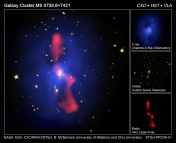Title: A small and vigorous black hole in the early universe
Authors: Roberto Maiolino, Jan Scholtz, Joris Witstok, et al.
First Author’s Institution: Kavli Institute for Cosmology, University of Cambridge, Cambridge, UK; Cavendish Laboratory – Astrophysics Group, University of Cambridge, Cambridge, UK; Department of Physics and Astronomy, University College London, London, UK
Status: submitted
As we near the one year anniversary of the release of the first images from JWST, it’s a perfect time to look back at some of its big discoveries. Observing in the infrared, JWST was—in part—designed to study the formation and evolution of the first galaxies in the universe. On that front, it has exceeded expectations, shattering records for galactic distance and challenging our models for early galaxy structure and demographics. A perfect example of just how powerful JWST is is in the new information we can learn from the old (pre-JWST) record holder for the most distant galaxy, catchily named GN-z11.
Ever since it was first photometrically identified as a high-redshift galaxy candidate in 2016, GN-z11 has been the subject of much excitement, largely because it was our clearest view into the nature of galaxies in the nascent universe. Not only was GN-z11 the highest-redshift galaxy ever detected to that point (with a redshift of ~11, placing it only around 400 million years after the Big Bang), but it is also exceptionally bright for its age. And no, I don’t mean that it was reading at a high school level in kindergarten. That is, it is three times as bright as a typical galaxy at z~6-8, when the universe was already almost a billion years old and galaxies are expected to be much bigger. GN-z11 has already been discussed at length in other bites (such as these two on its spectroscopic confirmation and origin), which were based on observations carried out with the Hubble Space Telescope and other ground-based studies.
Given such interest, GN-z11 was a natural observing target for some of the first science programs carried out by JWST. Today’s paper dives into these observations and presents evidence to explain the remarkable luminosity of this galaxy: perhaps there’s something playing hide-and-seek in the galaxy and making it shine so brightly!
How to detect a high-z AGN
Even with the observations carried out prior to JWST’s launch, GN-z11 was identified as a remarkably luminous galaxy. Assuming that all of that light is starlight, we would estimate that the mass of stars in the galaxy is equivalent to roughly a billion suns—approximately a factor of ten smaller than the Milky Way’s stellar mass—making it also exceptionally massive given its age. However, one possible explanation for its striking luminosity is that a large fraction of the light is being produced by an actively accreting supermassive black hole at the center of the galaxy (a so-called active galactic nucleus, or AGN). The presence of a large luminosity object like an AGN would neatly help relax some of the tension associated with the detection of GN-z11 and other similarly ‘over’-luminous galaxies in the early universe. While this is a potentially compelling idea, conclusively answering this question requires precise detection of emission lines in the galaxy’s spectrum—the perfect testbed for JWST’s high-resolution instruments!
Indeed, today’s authors use data collected with the Near-Infrared Spectrograph (NIRSpec) aboard JWST, which covers the wavelength range of 1-5 microns. Because the light has been stretched by the expansion of the universe, or cosmologically redshifted, the lines observed in this range are actually emitted in the ultraviolet or optical by atoms in the galaxy before being stretched into the infrared. In fact, some of the strongest lines—those that are used to identify the galaxy’s redshift—are produced by electron transitions in atoms that have been ionized and excited in the interstellar medium of the galaxy (e.g., in an HII region). Therefore, detecting various emission lines indicates the presence of particular elements and reflects the ionization state (read: fraction of atoms of a particular type that have been ionized) of the gas being observed.
It turns out that the ionization state can be a powerful probe of the presence of an AGN at the center of the galaxy. Detailed modeling of the ionizing spectrum produced by an AGN yields predictions for which emission lines we should see and their associated strengths. For example, today’s authors identify a pair of closely-spaced lines (called a doublet) associated with triply-ionized neon in the spectrum of GN-z11 (see Figure 1). Ionizing neon requires very high energy photons that could only reasonably have been produced by an AGN!
Measuring the shape of these emission lines can also shed light into the nature of the ionization source in the galaxy. The strong gravitational force and radiation pressure from the central massive black hole can drive rapid motion of the gas surrounding an AGN. As a result, individual components of the cloud will have their emission lines Doppler shifted according to the velocity of their motion. When we observe the galaxy as a whole and view the contributions of the Doppler shifts in aggregate, we see some components are redshifted and others blueshifted, producing an overall broadening of the line profile. To test this, the authors fit a Gaussian profile to the shape of their detected lines and measure the velocity of the gas, which will be given by the width of the lines, finding velocities of ~400 km/s for many of the high-ionization emission lines (Figure 1). While these velocities are smaller than the characteristic velocities observed in lower-redshift broad-line regions (which are often of order 1000 km/s), such velocities are allowed by AGN models and simply indicate that the black hole is smaller (less massive) than those we observe locally, so this is probably a toddler AGN.
Building baby black holes
Given the convincing identification of various pieces of evidence that GN-z11 hosts a young black hole roughly a million times the mass of our sun, it is natural to ask from whence this black hole came. The provenance of the first supermassive black holes remains an open question, so observing black holes at high redshifts can help inform their buildup over cosmic time. To begin tackling this, today’s authors calculate growth histories that can produce their measured black hole mass through two regimes (Figure 2). If the baby black hole grows by accretion at the Eddington limit (a theoretical maximum accretion rate before radiation pressure would stifle any further growth), then it likely started off as a so-called heavy seed, where it first formed at roughly a thousand times the mass of our sun. On the other hand, if the black hole formed from the collapse of a massive star around 10-100 times the mass of our sun, it must have accreted beyond the Eddington limit (super-Eddington accretion) to reach its mass today.
Finally, they ask what this black hole might do when it grows up. By tracing forward the growth histories in time, they find that Eddington-limited accretion from a heavy seed can predict both the observed mass of GN-z11’s black hole and the observed population of massive black holes at lower redshift, while the other channel cannot. In turn, they find that the black hole doesn’t appear to follow the low-redshift relations between central black hole and galaxy stellar mass, indicating that such relations may need to be revised at high redshift.
On the whole, such a detection showcases the potential for JWST to provide us with an exciting new lens into the role of AGN in early galaxy formation and into the properties of black holes at high redshift. Despite no longer being the highest redshift galaxy we’ve detected (thanks JWST), GN-z11 continues to provide us with more science and excitement and is sure to teach us even more in the coming years, so stay tuned!
Astrobite edited by Storm Colloms
Featured image credit: adapted from pixabay




